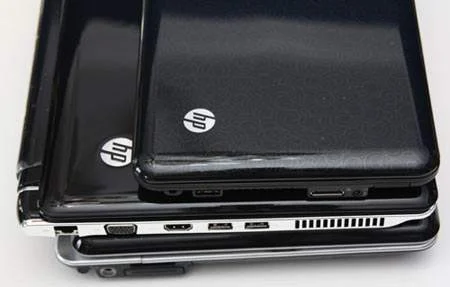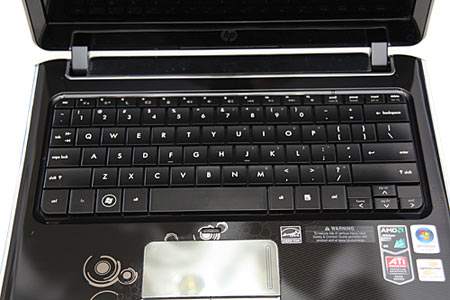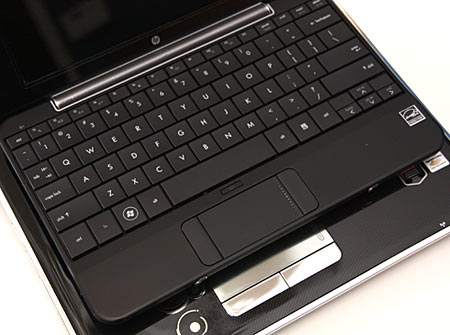Opinion – Question: If you need a notebook for travel, and just don’t care for one of those 17” monsters that should not be called notebooks anyway, which one would you choose? I have been trying to find the perfect computer for more than 10 years and, finally, was certain I had found the best (note: I don’t say “perfect”) system last year: The HP Mini. Now AMD tells me there this a better option than my netbook – the slim HP Pavilion dv2. Are they right? Chime in to let me know what you think.
If you are like me and you value notebooks for their traditional characteristics – a small, portable form factor with decent battery life with a trade-off in computing capability – then you may have found yourself in the same dilemma. What do you buy in the 10.4” to 12.1” segment?
In general you have two very different options and I’ll focus on a new third option in this article. All three systems are HP systems – HP systems I have special and very personal relationships with. So take this article as a general view on notebook form factors that are a available to you today, from more than just one vendor.
Options 1 and 2
Two years ago, I purchased what I felt back then was the best 12.1” notebook – the HP Pavilion tx1000 “Entertainment” notebook with 2 GB memory, a 160 GB hard drive, an AMD Turion X2 processors and Windows Vista. It was the first generation of the convertible notebook without the touchscreen and I concluded after a few weeks of use that it was the worst notebook to have ever come out of HP.

A start-up time of three minutes, a battery time of less than 2 hours, a boatload of crapware, a weak CPU and HP’s strange love for glossy and girly surfaces that show every fingerprint left me with the impression that my $1200 had been a waste of money. At least the computer was portable and I could write articles in airplanes without having to fear that my screen would be crushed when the person in front of me leaned back. The tx1000 received a successor, called the Touchsmart tx2z series, which starts at $900. Its design and hardware still looks a lot like my tx1000.
The second notebook I bought from HP was a Mini 8.9” netbook, arguably one of the best portable computers HP has ever built for travel purposes. It runs Windows XP, has an Intel Atom N270 CPU and 8 GB SSD storage (extended with 2 GB USB flash + 16 GB SD card flash memory.) You can’t run the latest software on it, but it is sufficiently fast with Photoshop 5 as well as Microsoft Office 2003. With the exception of the girly glossy surface of the device (gee, HP, who comes up with those strange circle designs?) and with some flexibility to run older software, this is enough for most business travelers, especially if you choose the 10” version.
You can even do Powerpoint presentations on it. I still believe this is one of the best netbooks on the market and its keyboard is the best available, hands down (I will forget the smallish trackpad at this point.)
Option 3: HP Pavilion dv2z
So we know that AMD does not have a rival for Intel’s Atom processor and won’t have one for probably another two years. But AMD decided to challenge Intel with the Neo CPU. It is a 65 watt CPU based on the Athlon single-core architecture, which results in a chip that is considerably larger than Intel’s Atom chip. It also consumes more power – 15 watts vs. 2 watts for the Atom. These two circumstances mean you won’t see the Neo in netbooks. But the CPU is small enough to be integrated in “cheap” ultrathin notebooks, such as the HP dv2.

The dv2 is a 12.1” notebook that has a slightly larger footprint than the tx2z, but it is much thinner – in fact, it is thinner than the Mini. Performance and price-wise, it is designed to slot right in between $300-$500 Mini netbooks (some can actually cost up to $1000) and the tx2z. $750 buys 4 GB of memory, a 320 GB hard drive, a Radeon 3000 series graphics chip as well as the option to add an external Blu-ray drive.
So, with those three options in mind, what do you buy? The full-featured and 4.65 lbs heavy tx2z, the thinner and less capable 3.95 lbs dv2z or do you forget all performance options in exchange for ultra-portability and go for a 2.25 lbs light computer? Here’s my take. For travel purposes, there is no compelling reason to buy the tx2z, at least if you don’t need the touchscreen. Processing power and the battery do not live up to what we would expect from a portable notebook these days. We are left with the dv2 and the Mini. Is the dv2 a compelling compromise between the heavy tx2 and the netbook? Is the dv2 a notebook the mainstream market would want?
Read on the next page: What makes the dv2 an interesting choice for the mainstream and why it won’t kill the netbook
What makes the dv2 an interesting choice for the mainstream
AMD and HP are clear about the positioning of the dv2. At $750, it is a mainstream device that aims to show the sex appeal of a Macbook Air (well, at least as far as size is concerned) at less than half the prize. The hardware is designed to do everything from editing text and spreadsheets as well as listening to music and watching movies. And if you want to play a game, there’s a decent graphics chip that would support an array of current games as well. Just don’t run any benchmarks.
AMD believes that the mainstream market is larger than the netbook market. Looking at the current sales numbers, that may be a questionable statement in a year or two and I don’t want to get in the middle of this discussion. But those who are looking for an affordable notebook and are wondering whether they should buy a netbook or not, should always remember that netbooks are content viewing devices, not content creation systems. If you want to do more than just browse the Internet, there is no question that a 12” class notebook will be a much better choice than a netbook.
In that view, the dv2 looks and feels much more like a traditional notebook. The only common feature with the Mini is the keyboard: Both systems share the exact same keyboard, albeit the dv2 has a much more effective trackpad. The dv2 runs Vista (given the 2 minute startup time, Win XP may actually have been a better choice) has 4 GB memory and a 320 GB hard drive. You won’t find that much capacity in netbooks, thanks to Intel’s and Microsoft’s design restrictions. It has a bright 12.1” LED display and an AMD Mobility Radeon HD 3410 graphics chip. As most PCs, it comes with a bunch of crapware (the 8 GB SSD Mini has substantially less trial software preinstalled) and HP’s not-so-great “Advisor” application – which helps to set up the device initially, but is rather annoying later on.
dv2 advantage 1: Design
The basic hardware of the dv2 isn’t exactly exciting. The big deal about the notebook is its slim design. In fact, bringing a device this slim into the $750 market is impressive. Conceivably, the dv2 looks much more expensive from many angles. However, I am not a big friend of the surface design and the shiny finishes. The (plastic) lid is painted in a glossy metallic black, the sides are covered in shiny silver plastic. It may look nice when you remove the device from the box, but play with it for half an hour and you will find yourself cleaning the surface area of the dv2 (the Mini comes with an excellent cleaning cloth, by the way.) At least there is no surface pattern on the lid. But there is a strange circle pattern surrounding the area below the keypad. I know, design is a matter of taste, but gee, do we really need those circles, HP? My personal opinion is that the dv2 is actually devalued by its glossy surface and the strange circle surface design.

However, even if the paint job isn’t exactly what I would like to see on my notebook, the form factor is about as good as it can get in this price segment. No question about it.

dv2 advantage 1 ½: Blu-ray
If you want to, you can equip your dv2 with an external Blu-ray drive. My tester came with that option and I heard that some users actually use this combination as a Blu-ray player for their TV, since there is an integrated HDMI ports (the fan noise of the dv2 is somewhat annoying though.) I can’t deny that Blu-ray is something you can’t get with a netbook even if you wanted to. Windows XP, which is installed on most netbooks, and the hardware simply won’t support it. But is Blu-ray really a killer feature for this notebook? No.

I personally believe that using it as a family room Blu-ray player may be a bit awkward and the dv2 is virtually useless as a mobile Blu-ray player. In my two test runs, the notebook shut down after 62 minutes of movie playing with Wi-Fi on and after 76 minutes with Wi-Fi off. So don’t expect to watch an entire movie on one battery charge (my dv2, however, came with two battery packs.) So think twice about the Blu-ray option if you want to play movies on the dv2 during flights.
For now, Blu-ray is a nice touch. But it certainly is not something that will close the deal for the dv2.
Conclusion: It’s all about choice
Let’s be realistic here. The dv2 is an extremely important product for AMD to compete in a price range that is close to netbooks. It carries AMD’s Neo processor, a product that has been created to counter the success of Intel’s Atom processor. Of course, the Neo can’t touch the netbook market Atom is addressing and AMD thinks that the mainstream market does not want a netbook anyway. So there may be an opportunity.
I absolutely agree with AMD that the dv2 is a fantastic device for those who expect a basic computing experience in a stylish package. If HP can finally clean up the surface design, the dv2 is a convincing choice for a broad range of mainstream applications.
My issue with the dv2 is that it is a compromise between the traditional notebook and the netbook and you see and feel it. Emotions are usually carried by extremes – extremes that are shown, for example, by netbooks. Like a lot of other Windows notebooks, the dv2 appears to be over-designed and turns out not be an emotional device. It is not what you would call a purpose-built device, but a notebook that wants to bridge the gap between ultra-portables and more expensive entertainment notebooks, and comes in a somewhat more stylish package than the traditional $750 notebook. In that sense, it is a decent contender for mainstream applications that will do most mainstream things well.
Personal take
I have to admit that I am not a big fan of notebooks. I love my powerful desktop PC and use notebooks as an extension for business trips that usually last less than three or four days. I am used to only bringing the most essential data with me on my trips and I focus on only dragging along what I absolutely have to bring – from today’s perspective, a smartphone and a decent netbook. With netbooks evolving as they do, and with the second generation Atom CPU on the horizon, I have little doubt that the netbook will evolve into the product Intel and Microsoft once hoped the UMPC to be.
It is clear to me that the dv2 and similar notebooks will not kill the netbook. But it is another option for the mainstream and there is nothing wrong with that. It is yet another sign that the notebook is turning into a commodity. If you are looking for “just” a notebook to do your everyday tasks, this is a good device to look at. But it is nothing to get excited about.
Wolfgang Gruener is the founder of TG Daily. The opinions expressed in this commentary are solely those of the author.






